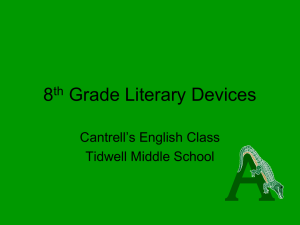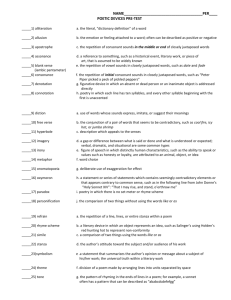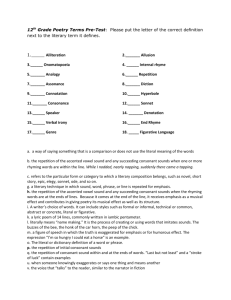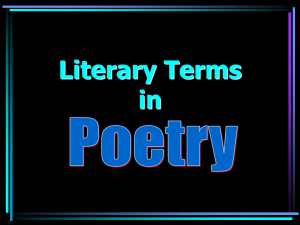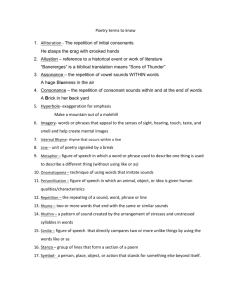8th Grade Literary Vocabulary
advertisement
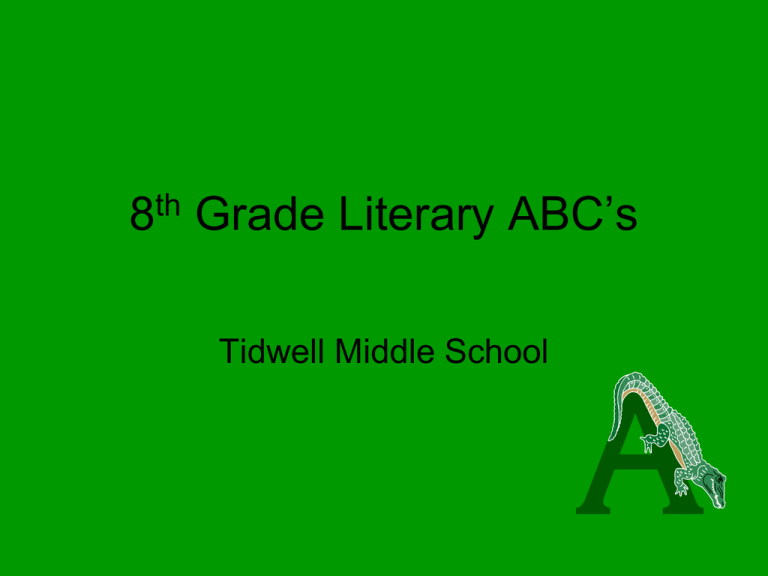
8th Grade Literary ABC’s Tidwell Middle School Alliteration • The repetition of initial consonant sounds Allusion • A reference to a literary, mythological, or historical person, place, or thing. Anadiplosis • The repetition of a word or clause at the end of one sentence is repeated at the beginning of the next successive sentence. Anaphora • The repetition of a word or clause at the beginning of successive sentences. Antagonist • The character opposing the protagonist; can be a person, idea, or force. Antithesis • Using opposite phrases in close conjunction – especially within a sentence. Apostrophe • The act of addressing something – idea or personification of an idea that is not physically present. Archetype • A type of character, action, or situation that occurs over and over in literature; a pattern or example that occurs in literature and life. Assonance • Repetition of vowel sounds but not consonant sounds Character vs. Character • When a character has a problem with another character Character vs. Fate • Character vs. Fate • When a character has a problem with something he can’t do anything about, such as God, luck, death, etc. Character vs. Nature • When a character has a problem with a force of nature, such as cold, storms, earthquakes, etc. Character vs. Self • When a character must make a decision about a problem or struggle he is having within himself. Character vs. Society • When a character has a problem with a tradition or rule of society. Characterization • The methods used by an author to create a character, including: • The character’s physical appearance • The characters own speech, thoughts, actions, and or feelings • Other characters’ feelings, actions, thoughts, or speech toward the character • Direct comments by the author about the character Climax • The most critical moment in the story; the point at which the main conflict is at its highest; that is, the point of no return. Conflict • A struggle between two opposing forces Connotation • The emotions or associations a word normally arouses in people using, hearing, or reading the word. The feeling may be positive, negative, or neutral. Consonance • The repetition of consonant sounds, but not vowel sounds. Denotation • The specific dictionary definition of a word. Detail • Facts revealed by the author or speaker that support the attitude or tone in the work. Device • Any literary technique used to achieve a specific effect. Dialect • The language of a particular district, class, or group of persons. It encompasses the sounds, spelling, grammar and diction used by a specific group of people as different from other people either geographically or socially. Diction • Word choice. An author chooses words to create a specific effect. It is the appropriateness of the words with regard to the emotions and or ideas associated with them. Dynamic Character • A character that undergoes a change in actions or beliefs during the course of a story. Epanalepsis • The repetition of a word or clause at the beginning and end of the same sentence. Epiphany • An event in which the essential nature of something, a person, a situation, an object, is suddenly realized in a new way; a sudden realization; an “a-ha” moment. Epistrophe • The repetition of a word of clause at the end of successive sentences. Euphemism • The substitution of an agreeable expression to replace one that is offensive. Exposition • The author lays the groundwork for the story by revealing the: • -Setting • -Relationships between the characters • -Situation as it exists before the conflict begins Falling Action • Events that occur after the climax and lead up to closure and conclusion of the story. Figures of Speech • Words or phrases that describe one thing in terms of something else. They always involve some sort of imaginary comparison between seemingly unlike things; not meant to be taken literally. Flashback • An action that interrupts the plot to show an event that occurred at an earlier time which is necessary to better understanding. Foreshadowing • The use in a literary work of clues that suggest events that have yet to occur. Hyperbole • A deliberate, extravagant and often outrageous exaggeration; may be used for either serious or comic effect. Iamb • A combination of one unstressed, and one stressed syllable in the following pattern [ U / ] Idiom • An accepted phrase or expression having a meaning different from the literal. Imagery • The words or phrases a writer uses to represent persons, objects, actions, feelings and ideas descriptively by appealing to the five senses (sight, sounds, smell, taste, and touch). Inciting Incident • Interrupts the peace and balance of the situation and one or more of the characters come into conflict with an outside force, himself, or another character. Irony • A contrast between appearance and reality. It is usually one in which reality is the opposite from what it seems; when one thing is expected to happen or be, and the exact opposite occurs. Magic 3 • Three (or more) details in a series used for emphasis or to create a specific effect. Metaphor • A comparison of two unlike things WITHOUT the use of LIKE or AS. Meter • Measure of rhythm in a poem. Mood • The feeling created in the reader by a literary work or passage. Motif • A recurrent element in a literary work. A pattern or strand of imagery or symbolism within a work of literature. Motivation • A reason that explains a character’s thoughts, feelings, actions, or behavior. Onomatopoeia • A word that imitates the sound it represents. Oxymoron • A form of paradox that combines a pair of opposite terms into a single unusual expression. Paradox • When elements of a statement contradict each other; may appear illogical, impossible, or absurd, but turns out to reveal a hidden truth. Personification • Writing that gives nonhuman subjects human characteristics. Point of View • The perspective from which a story is told. • 1st Person – use of pronoun ‘I,’ ‘me,’ ‘we,’ ‘us,’ ‘my’ • Third Person Limited- told from the perspective of one character only. • Third Person Omniscient – told from the perspective of more than one character. Protagonist • The central character and focus of interest that tries to accomplish or overcome an adversity, and has the ability to adapt to new circumstances. Pun • A play on words that are identical or similar in sound but have sharply different meanings. Puns can have serious as well as humorous uses. Refrain • A stanza or line that is repeated within a poem. Repetition • A device in which words, sounds, and or ideas are used more than once to enhance rhythm and to create emphasis. Resolution • The problem set up in the inciting incident is unraveled; there is a revelation of meaning. Rhyme • A pattern of words that contain similar sounds. Rhythm • The movement with uniform occurrence of a beat or accent. Rising Action • The action and events that take place in the story and build up to the critical moment when the main conflict is confronted. Setting • The time and place of a literary work. Simile • A comparison of two different things or ideas through the use of the words LIKE or AS OR THAN. Stanza • A paragraph in a poem. Static Character • A character that does not grow or change throughout the story. Suspense • The quality of a literary work that makes the reader uncertain or tense about the outcome of events. Symbol • The use of any object, person, place, or action that both has a meaning in itself and that stands for something larger than itself, such as a quality, attitude, belief, or value. Theme • A central message or insight into life revealed through the literary work. A lesson about life or people. Tone • The writer’s attitude toward his or her subject. It can often be described by a single adjective. Trochee • A combination of one stressed, and one unstressed syllable in the following pattern [ / U]
